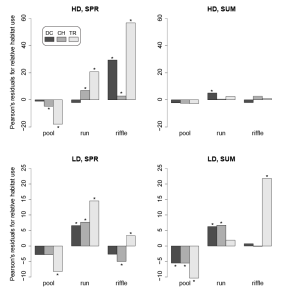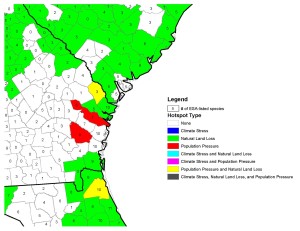Hackers defaced this site and several others on this server recently, so I have locked down the old WordPress theme I had been using. I had customized it pretty heavily back before such changes could easily be propagated to via theme updates, so things may look a little spare around here until I can get something else installed.
|
I recently coordinated a project between the UGA River Basin Center and the great folks at the Tennessee Aquarium Conservation Institute to develop a prioritization for aquatic conservation in the Southeast. We used museum records, state natural heritage data, and even some individual researchers’ personal collections to develop range maps for almost 1,050 species of fishes, mussels, and crayfishes. Find out more about the project at Southeastfreshwater.org. This report and the ESRI Story Map that accompanies it got a surprising amount of press, appearing in newspapers as far away as New York. This was a fun analysis— an update of Ken Cordell’s “Footprints on the Land” in which we intersected county-level projections of temperature change with models of population growth and land use change out to 2060 to identify areas where climate change may further complicate natural resources management. Once we’d identified these “Hotspots” using a technique called Local Indicators of Spatial Association (LISA), I overlaid T&E species and existing protected areas to show that these areas currently support high numbers of vulnerable and listed species and that the existing reserve network doesn’t provide much opportunity for communities to move, even in the West. Neelam Poudyal added a nice examination of the indicators of human community resiliency within and outside these hotspots that nicely complements the story on the natural communities. Folks have asked for zoomed-in maps of smaller areas such as the Georgia coast, shown below. I’m happy to provide these, though the T&E species data might be better from my current project, at least for freshwater aquatics. Citation is below. Snag it from the Land Use Policy website here, or drop me a line and I’ll send you a PDF. Full reference: Poudyal, N., Elkins, D., Nibbelink, N., Cordell, K., & Gyawali, B. (2016). An exploratory spatial analysis of projected hotspots of population growth, natural land loss, and climate change in the conterminous United States.Land Use Policy, 51, 325–334. doi:10.1016/j.landusepol.2015.11.021
The workshop paper from the aquatic connectivity session Kyle McKay organized at last years ISRS meeting in LaCrosse has recently come out in River Research and Applications. In it, we review 40+ studies covering various aspects of barrier analysis and prioritization and propose a workflow for approaching connectivity analysis. Kyle did a great job involving someone from each of the several groups working to scale up barrier assessment and removal prioritization to the regional level and driving the resulting publication forward— I’m grateful to him for inviting me into the symposium. The citation is below. You can get it from Wiley here or email me for a PDF. , , , , , , and (2016) Informing Watershed Connectivity Barrier Prioritization Decisions: A Synthesis. River Res. Applic., doi: 10.1002/rra.3021. Elkins and Grossman 2013 is out. If you have journal access you can grab it from Biological Invasions. If not, drop me a line. This is the first of the papers from my dissertation, I’ve been pretty tied up with post-doccing and writing up those results- look for the other two, soon. I’m pleased with the way one figure came out, in particular. I used a partial chi-square analysis to see if any of the habitat shifts we observed by the warpaint shiners were significant, since a typical chi-square would only say, “Nope, these two distributions aren’t the same.” What jumps out of this small-multiples presentation, I think, is that the native fish moved more dramatically after trout addition than they did in either of the controls (though some of the controls were significant, for reasons we discuss in the paper), regardless of the season or size of the group. The direction of those moves was fairly consistent and matched what I observed anecdotally; when the trout took up residence in the pool, the minnows moved forward into the pool and, in some cases, even into the riffle section of the tank. This is probably a big deal, energetically, since the currents were higher in those habitats, and that’s the subject of the third paper.  Pearson residuals from a chi-square analysis of the habitats occupied by warpaint shiners. I used the control period as the baseline for this analysis, so each bar represents deviation from the habitat usage observed when the minnows were left to their own devices. Here’s the reference: Elkins, D. and G. Grossman (2013). “Invasive rainbow trout affect habitat use, feeding efficiency, and spatial organization of warpaint shiners.” Biological Invasions: 1-15. And the abstract: Rainbow trout have been introduced to six of the seven continents and currently are widely stocked for sport fishing. Despite their broad distribution, outside of New Zealand, little is known about the effects of rainbow trout on native species, especially fishes. We conducted experiments in an artificial stream to assess hypotheses that stocked rainbow trout significantly affected: (1) mesohabitat use, (2) foraging success, (3) social behavior, and (4) spatial organization of warpaint shiners (Luxilus coccogenis) a common native minnow found in southern Appalachian streams, with similar patterns of microhabitat use to rainbow trout. We replicated experiments at high and low natural densities (two and five warpaint shiners) and spring/fall (12 °C) and summer (17 °C) temperatures. Treatments included: (1) a control (five warpaint shiners), (2) trout (five warpaint shiners and one rainbow trout), (3) large fish control (five warpaint shiners and one river chub) and (4) density control (six warpaint shiners). The presence of rainbow trout produced a shift by warpaint shiners from pool mesohabitats to shallower, higher velocity habitats with more variable substrata, as well as reduced prey capture success, feeding efficiency, and distance from the front of the tank (i.e., warpaint shiners moved closer to food release points), and increased the distance to the additional fish (i.e., avoidance of the rainbow trout). Negative effects on foraging behaviors were stronger in 12 °C treatments. In a realistic stream flume the presence of rainbow trout produced effects that likely influenced individual fitness of warpaint shiners. The potential effects of stocking rainbow trout on native non-game fishes, such as warpaint shiners should be assessed when implementing or evaluating stocking programs. Here’s an invited seminar I delivered at Warnell in February, 2012. Stocking the wily rainbow trout: what happens to native fishes after the hatchery truck pulls away?
Here’s a little talk I gave during the Georgia Climate Change Coalition’s first symposium on Climate Change in the Southeast. Though my own recent research on stream connectivity and fish passage barriers is only a small part of it, it was a nice general-audience opportunity to link the findings of studies by other UGA folks in the context of the AFS policy document on fisheries and climate change.
Duncan Elkins,
I’ve just finished a simple e-commerce site for Scott Thornton, a custom rodbuilder. His site, Home Team Rods, is the only officially-licensed producer of UGA-logo fishing rods. You know you want one, so check it out. I’ll be adding more information to this site, shortly. The plan is for it to be a place for me to play around with Word Press and post portfolio material: CVs, links to sites I’ve designed, etc. The sites that other people pay for are likely to be better examples of my work, since cobblers’ kids have tough feet, anyway. Blogging will be done over at Verbum Sat, someday. For now, this is better than the “Nothing to see here” page, isn’t it? |
FishFoodFishing |
